>
During the 10-year span of the American Football League, more than 1,400 men suited up and played at least one down in a regular season AFL game. They range alphabetically from Ray Abell (Chiefs linebacker, 1966-1968) to Bob Zeman (Chargers and Broncos defensive back, 1960-1966), with John Frongillo (Oilers guard, 1962-1966) and Ray Ratkowski (Patriots halfback, 1961) falling somewhere in between. But of all 1,400, only 20 of them lasted for the entirety of the league, from preseason 1960 through Super Bowl IV after the 1969 season. Here is a breakdown of the 20 Ironmen of the AFL.
Larry Grantham – At 6-foot, 206-lbs, Larry Grantham was a small linebacker even by 1960s standards. The Mississippi alum called the Jets’ defensive signals, and was a critical member of New York’s Super Bowl III-winning defense.
Jack Lee – Besides being a 10-year AFL member, Jacky Lee is notable for being the only “loaner” quarterback in league history. After the 1963 season, the Houston Oilers “loaned” Lee to the Denver Broncos for two years. He returned to Houston in 1966. He was traded to Kansas City in 1967, and finished his career there in 1969.
Billy Cannon – The 1959 Heisman Trophy winner from LSU was the AFL’s prize rookie signee in 1960, and helped lead the Oilers to league championships in 1960 & 1961. After back problems cut short his time at running back, he was traded to the Oakland Raiders, fro whom he became an all-star tight end.
Paul Maguire – A graduate of The Citadel, Paul Maguire played in the first six AFL championship games, and was on the winning side in 1963 (Chargers), 1964 & 1965 (Bills). After his playing days ended, the linebacker and punter made a name for himself as a broadcaster.
Harry Jacobs – Harry Jacobs went from being a taxi squad member in the NFL to the starting middle linebacker for the Patriots in 1960. He remained the defensive signal caller in Boston until 1963, when he took over the same position in Buffalo and remained until the last game of the 1969 season.
Bill Mathis – Mathis, a fullback from Clemson, began his career with the Houston Oilers, but was traded to the New York Titans (Jets) before ever playing a single down in Houston. His rushing statistics are not exceptional, but he was highly-prized for his blocking and pass protection.
Jack Kemp – The quarterback-turned-congressman began his AFL career with the Los Angeles Chargers in 1960. After a thumb injury sidelined him in 1962, the Chargers lost Kemp to the Buffalo Bills on Sid Gillman’s misunderstanding of the waiver rules. The Chargers’ loss was the Bills’ gain, as Kemp led Buffalo over the Chargers in the ’64 and ’65 AFL championship games.
George Blanda – “Ageless” George Blanda was already 32 years old when he was quarterbacking the Houston Oilers in 1960. Blanda’s long career that began in 1949 with the Chicago Bears spanned four decades, and did not come to an end until after the 1975 season.
Johnny Robinson – A teammate of Billy Cannon’s in college, Robinson shifted to the defensive side of the ball in the pros. He quickly became an all-league player at safety, and was known around the league for his bone-crushing hits.
Paul Lowe – One of the original Chargers, Lowe took the first kickoff in team history and ran it back 105-yards for a touchdown. Lowe was the 1965 AFL Most Valuable Player and a two-time AFL all-star.
Gino Cappelletti – Cappelletti played wide receiver and kicked for the Boston Patriots all 10 seasons of the AFL. He was the league’s all-time leading scorer and the only AFL player to break the 1,000-point mark during his career.
Wayne Hawkins – A smallish guard at 6’ 0” and 240-lbs., Wayne Hawkins was a two-time AFL All-Star and a valuable member of the Raiders offensive line throughout the 1960s.
Ernie Wright – At 20 years old in 1960, Ernie Wright was one of the AFL’s youngest players. But his size, speed and tenacity made him an excellent tackle. After eight seasons with the Chargers, Wright went to the Cincinnati Bengals in the expansion draft and provided veteran leadership for the young team.
Babe Parilli – After playing in the NFL and Canada, Babe Parilli found a home in the AFL. He began with the Raiders, and then spent the bulk of his time with the Patriots before backing up Joe Namath with the New York Jets.
Jim Hunt – Hunt earned his nickname, “Earthquake,” because of a rumbling 78-yard interception that he returned for a touchdown. Far from the stereotypical defensive lineman at 5”11” and 255-lbs., Hunt excelled because of his speed and technical style of play.
Tom Flores – Flores became the first Hispanic-American quarterback in pro football when he took the helm for the Oakland Raiders in 1960. He threw for nearly 12,000 yards in his career with the Raiders, Buffalo Bills and Kansas City Chiefs.
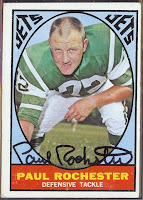 Paul Rochester – After initially being cut by the Dallas Cowboys of the NFL, Paul Rochester earned a starting position in the AFL and won an AFL championship with the Dallas Texans in 1962, and a Super Bowl championship with the New York Jets in 1968.
Paul Rochester – After initially being cut by the Dallas Cowboys of the NFL, Paul Rochester earned a starting position in the AFL and won an AFL championship with the Dallas Texans in 1962, and a Super Bowl championship with the New York Jets in 1968.  Jim Otto – The AFL’s premier center, Jim Otto came into the league at a light 205 lbs. He eventually built himself up to 260. In his 10 seasons in the AFL, Otto played in 203 games (all preseason, regular and post-season included), missing only one Raiders preseason game. He was the definition of reliability.
Jim Otto – The AFL’s premier center, Jim Otto came into the league at a light 205 lbs. He eventually built himself up to 260. In his 10 seasons in the AFL, Otto played in 203 games (all preseason, regular and post-season included), missing only one Raiders preseason game. He was the definition of reliability.Ron Mix – A highly-intelligent player, Mix was called the “Intellectual Assassin.” AA blend of size, strength and surprising speed, Mix is thought by many to be the most technically-perfect tackle in the history of professional football. He was called for holding only twice in his career, and to this day refutes both calls.
Don Maynard – Another man who played in the NFL and Canada before finding a home in the AFL, Don Maynard was an immediate deep threat for the New York Titans. In 1965, Joe Namath took over as the Jets quarterback, and he and Maynard helped each other to Hall of Fame careers for the next several years.



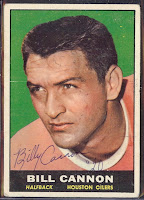
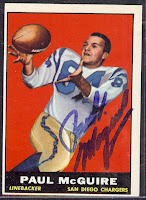




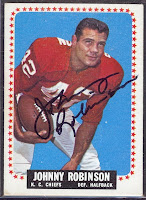



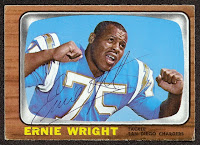
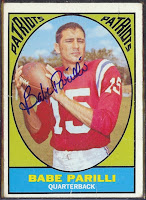

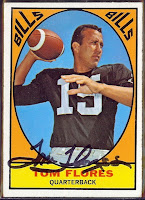


[…] Don Maynard […]
[…] of the game itself. But Maguire is more than just a glib analyst. He is also one of just 20 men to play all 10 seasons of the American Football League. He was drafted by the Los Angeles Chargers in 1960, moved to San Diego with the team in 1961, and […]
… [Trackback]
[…] There you can find 75753 additional Info on that Topic: talesfromtheamericanfootballleague.com/the-afls-10-year-men/ […]
… [Trackback]
[…] Read More on on that Topic: talesfromtheamericanfootballleague.com/the-afls-10-year-men/ […]
… [Trackback]
[…] Info on that Topic: talesfromtheamericanfootballleague.com/the-afls-10-year-men/ […]
… [Trackback]
[…] Read More Info here on that Topic: talesfromtheamericanfootballleague.com/the-afls-10-year-men/ […]
… [Trackback]
[…] Here you will find 36772 more Information to that Topic: talesfromtheamericanfootballleague.com/the-afls-10-year-men/ […]
… [Trackback]
[…] Read More Information here on that Topic: talesfromtheamericanfootballleague.com/the-afls-10-year-men/ […]
… [Trackback]
[…] Read More Information here on that Topic: talesfromtheamericanfootballleague.com/the-afls-10-year-men/ […]
… [Trackback]
[…] Find More to that Topic: talesfromtheamericanfootballleague.com/the-afls-10-year-men/ […]
… [Trackback]
[…] Find More Info here on that Topic: talesfromtheamericanfootballleague.com/the-afls-10-year-men/ […]
… [Trackback]
[…] Read More Information here on that Topic: talesfromtheamericanfootballleague.com/the-afls-10-year-men/ […]
… [Trackback]
[…] Read More here to that Topic: talesfromtheamericanfootballleague.com/the-afls-10-year-men/ […]
… [Trackback]
[…] Find More here on that Topic: talesfromtheamericanfootballleague.com/the-afls-10-year-men/ […]
… [Trackback]
[…] Info on that Topic: talesfromtheamericanfootballleague.com/the-afls-10-year-men/ […]
… [Trackback]
[…] Read More on that Topic: talesfromtheamericanfootballleague.com/the-afls-10-year-men/ […]
… [Trackback]
[…] Here you can find 8621 additional Information on that Topic: talesfromtheamericanfootballleague.com/the-afls-10-year-men/ […]
… [Trackback]
[…] Read More Info here on that Topic: talesfromtheamericanfootballleague.com/the-afls-10-year-men/ […]
… [Trackback]
[…] Here you will find 76376 additional Information on that Topic: talesfromtheamericanfootballleague.com/the-afls-10-year-men/ […]
… [Trackback]
[…] Info on that Topic: talesfromtheamericanfootballleague.com/the-afls-10-year-men/ […]
… [Trackback]
[…] Read More to that Topic: talesfromtheamericanfootballleague.com/the-afls-10-year-men/ […]
… [Trackback]
[…] Read More on to that Topic: talesfromtheamericanfootballleague.com/the-afls-10-year-men/ […]
… [Trackback]
[…] Find More on that Topic: talesfromtheamericanfootballleague.com/the-afls-10-year-men/ […]
… [Trackback]
[…] Find More on that Topic: talesfromtheamericanfootballleague.com/the-afls-10-year-men/ […]
… [Trackback]
[…] There you can find 34663 additional Information to that Topic: talesfromtheamericanfootballleague.com/the-afls-10-year-men/ […]